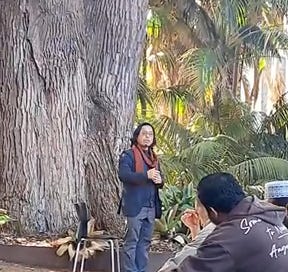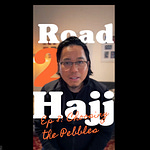Assalamu alaikum warahmatullahi wabarakatuh.
Rasulullah ﷺ began looking for a new base for Islam because of the intense persecution Muslims faced in Makkah. In the 10th year of prophethood, his uncle Abu Talib — the leader of Banu Hashim, the Prophet’s tribe — passed away. At that time, Makkah had no judicial system: your safety depended entirely on your tribal protection. As long as your tribe protected you, no one would harm you because your tribe could avenge any harm done.
When Abu Talib passed away, leadership of Banu Hashim went to Abu Lahab, who refused to protect the Prophet ﷺ. With no protection, the Prophet’s life was in danger. He went to Ta’if, hoping for refuge, but the people of Ta’if rejected him. He returned to Makkah with nowhere to turn, rejected by the people on earth.
So, in the 11th year of prophethood, he adopted a new strategy: during Hajj, he would go to Mina, where tribes from all over Arabia camped in tents for three or four nights. He approached them one by one, seeking a tribe that would accept Islam and provide protection.
First, he approached Banu Kindah — a once-powerful tribe that had lost its influence. The Prophet saw an opportunity for Kindah to regain prominence through Islam. Kindah, however, saw it only as a political opportunity: they told the Prophet they’d support him if leadership would pass to them after his death. The Prophet ﷺ refused, saying power belongs to Allah, who grants it to whomever He wills.
He then approached Banu Shaiban ibn Tha’labah. Sayyidina Abu Bakr described them as the most virtuous and intelligent tribe in Arabia. The Prophet invited them to Islam and to become a new base for Muslims. But Banu Shaiban were bound by treaties with Rome and Persia, which they feared breaking if they supported the Prophet. They asked him to give them more time. The Prophet left, having been rejected again.
On his way out, he met six men — not from a large or powerful tribe, but from the Khazraj. When the Prophet asked, “Who are you?” they replied, “We are Khazraj.” The Prophet ﷺ confirmed, “Khazraj living among the Jews?” They answered yes. Unlike the powerful tribes, these six men listened attentively to the Prophet’s message. They didn’t accept Islam immediately but were intrigued, promising to meet him the following year.
They returned to Yathrib (Medina’s old name) and shared the Prophet’s message with their families. The next year, 12 people from Yathrib came to pledge allegiance to the Prophet ﷺ and accepted Islam. They asked the Prophet to send a teacher, and he sent Sayyidina Mus’ab ibn Umair, who led the first da’wah mission in Yathrib.
The following year, in the 13th year of prophethood, 75 people from Yathrib came to pledge allegiance to the Prophet ﷺ — most from Khazraj, some from Aus. During the pledge, someone among them said: “How can we live safely in Medina while our Prophet remains oppressed in Makkah?” They invited the Prophet ﷺ to migrate. And the rest, as we say, is history: the Prophet ﷺ began encouraging companions to migrate, and eventually, Allah granted him permission to migrate himself.
My dear brothers, this story teaches us powerful lessons:
First, never underestimate small numbers. When building community strength, it’s logical to seek powerful allies — and we should. But never forget the power of quality over quantity. The Prophet approached the mighty Kindah and wise Shaiban but didn’t dismiss the small group of six sincere Khazraj. As we build our community, don’t neglect people who may not seem influential today but are sincere seekers of truth.
Second, community building requires cohesive teamwork across all segments of society. During the hijrah, the Prophet ﷺ worked with:
Sayyidina Abu Bakr, representing the elders.
Youth like Abdullah ibn Abu Bakr, who delivered food.
Sayyidatuna Asma bint Abu Bakr, a young woman who gathered intelligence.
Sayyidina Ali, a young man who risked his life sleeping in the Prophet’s bed.
Abdullah ibn Urayqid, a skilled non-Muslim guide who honored his trust with the Prophet.
The hijrah shows that everyone — elders, youth, men, women, Muslims, and even trustworthy non-Muslims — can contribute meaningfully to a cause. We cannot afford divisions: elders must not hoard power, and youth should not sit on the sidelines criticising. Both must collaborate.
Third, when the Prophet ﷺ reached Medina, the first thing he built wasn’t his own house — it was a masjid. After the masjid, he demarcated an area for a market. These two pillars — spiritual strength and economic strength — must go hand in hand.
Our masajid should be open, welcoming, and function as community hubs. They should host worship, education, and community activities. But we must also build our economic strength: as a minority community, politicians won’t listen to us because of our numbers, so we need economic power. This requires pooling our diverse talents — from money to skills — to establish projects that empower our community.
In summary, here are the three key lessons from the hijrah:
Never underestimate the potential of small, sincere groups — success doesn’t rely solely on numbers.
Build cohesive communities by involving people of all backgrounds, ages, genders, and talents.
Prioritise both spiritual and economic strength; they are inseparable for a thriving community.
أقول قولي هذا وأستغفر الله لي ولكم.












Share this post